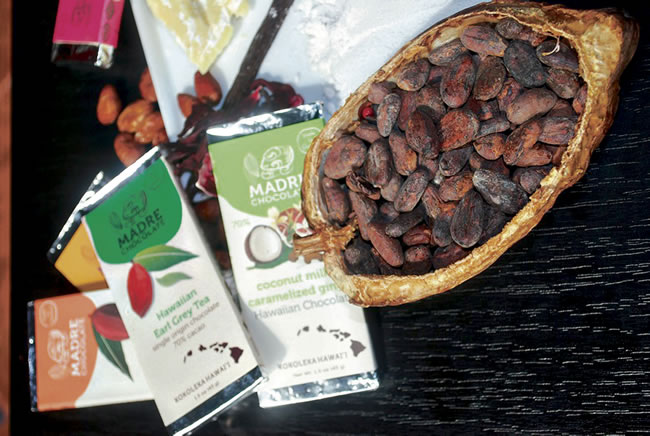The Ancient Wonders Of Chocolate
Dave Elliot is standing in front of a large stainless steel pot from which emanates the unmistakable aroma of chocolate.
“Would you like some?” he asks, an utterly infectious, warm grin spreading across his face. You half expect him to comment that he can’t really believe his job is making chocolate.
In fact, if you’d told Dave or partner Nat Bletter just a few years ago they’d be making one of Saveur magazine’s top 100 things to taste or featured in MidWeek‘s recent cover story on the growing cacaochocolate industry in Hawaii they might not have believed you.
Bletter, an ethnobotanist (think anthropologist who studies how people interact with plants), and Elliot met in the jungles of South America.
“I love to tell people that it all started deep in the jungle,” Elliot says in mock mad professorial style.
Having spent the better part of 10 years on conservation projects in the rain forests in South America, Elliot was already fascinated by the cacao tree: “I was amazed at this beautiful tree which made chocolate loved around the world but the people growing it didn’t benefit in any way.” There had to be, he thought, a way to make high-quality chocolate that benefited the region from which it came.
Enter Bletter, who’d been challenged by friends to make chocolate at home after authoring a chapter in the book Chocolate in Mesoamerica. The Mayans were like alchemists using chocolate and herbs to make incredibly complex drinks, and even foams. It’s not too different from the food chemistry perpetuated today by chefs like Feran Adria.
“The Aztecs and the Mayans have such an amazing culture, and their use of plants and herbs with chocolate is phenomenal,” says Bletter.
“We wanted to somehow incorporate that into chocolate making in the U.S. and have the people most closely involved with cacao trees benefit,” says Elliot.
For Bletter, reviving ancient recipes using mostly unknown plants is just part of the synergistic way their company is growing. And best of all, it’s all happening right here in Hawaii.
“As soon as we came to Hawaii, it was obvious that the only place where cacao grows in the United States was a natural place to be making chocolate,” he says.
Today you’ll find the two traveling between their chocolate shop in Kainehe Street in Kailua and small cacao farms on the Big Island and beyond.
The chocolate may be the best you’ll ever taste, and with each gourmet batch of chocolate made, more people are educated about the origins of fascinating plants and ancient herbs, and small farmers around the world benefit.
For ethnobotanist Bletter, the artisan chocolate affords the opportunity to bring ancient plants and their uses back to life. Like the Rosita de Cacao, a 70 percent dark chocolate based on an ancient Mayan recipe using the tiny white Oaxacan flower and prized Xoconusco cacao. Not enough that this chocolate is outstandingly good, it’s like tasting a piece of food history.
Expect to hear much more of Madre Chocolate; with a commitment to excellence, and to fair trade, Elliot and Bletter have created a company destined to become a huge success.
“We want our chocolate to inspire,” says Elliot, “both with the taste and with the story behind the chocolate.”
Eat chocolate. Be inspired.
Happy eating!
Madre Chocolate
377-6440
info@madrechocolate.com







